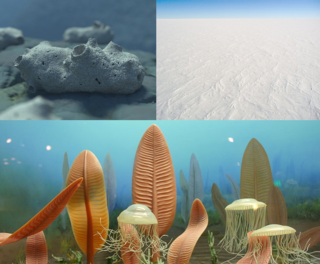
The Ediacaran is a geological period of the Neoproterozoic Era that spans 96 million years from the end of the Cryogenian Period at 635 Mya to the beginning of the Cambrian Period at 538.8 Mya. It is the last period of the Proterozoic Eon as well as the last of the so-called "Precambrian supereon", before the beginning of the subsequent Cambrian Period marks the start of the Phanerozoic Eon, where recognizable fossil evidence of life becomes common.

The Neoproterozoic Era is the unit of geologic time from 1 billion to 538.8 million years ago.

Dickinsonia is a genus of extinct organism, most likely an animal, that lived during the late Ediacaran period in what is now Australia, China, Russia, and Ukraine. It is one of the best known members of the Ediacaran biota. The individual Dickinsonia typically resembles a bilaterally symmetrical ribbed oval. Its affinities are presently unknown; its mode of growth has been considered consistent with a stem-group bilaterian affinity, though various other affinities have been proposed. It lived during the late Ediacaran. The discovery of cholesterol molecules in fossils of Dickinsonia lends support to the idea that Dickinsonia was an animal, though these results have been questioned.

Tribrachidium heraldicum is a tri-radially symmetric fossil animal that lived in the late Ediacaran (Vendian) seas. In life, it was hemispherical in form. T. heraldicum is the best known member of the extinct group Trilobozoa.

Yorgia waggoneri is a discoid Ediacaran organism. It has a low, segmented body consisting of a short wide "head", no appendages, and a long body region, reaching a maximum length of 25 cm (9.8 in). It is classified within the extinct animal phylum Proarticulata.

Cephalonega stepanovi is a fossil organism from Ediacaran deposits of the Arkhangelsk Region, Russia. It was described by Mikhail A. Fedonkin in 1976

Rangea is a frond-like Ediacaran fossil with six-fold radial symmetry. It is the type genus of the rangeomorphs.
Namacalathus is a problematic metazoan fossil occurring in the latest Ediacaran. The first, and only described species, N. hermanastes, was first described in 2000 from the Nama Group of central and southern Namibia.

Proarticulata is a proposed phylum of extinct, near-bilaterally symmetrical animals known from fossils found in the Ediacaran (Vendian) marine deposits, and dates to approximately 567 to 550 million years ago. The name comes from the Greek προ = "before" and Articulata, i.e. prior to animals with true segmentation such as annelids and arthropods. This phylum was established by Mikhail A. Fedonkin in 1985 for such animals as Dickinsonia, Vendia, Cephalonega, Praecambridium and currently many other Proarticulata are described.

Eoandromeda is an Ediacaran organism consisting of eight radial spiral arms, and known from two taphonomic modes: the standard Ediacara type preservation in Australia, and as carbonaceous compressions from the Doushantuo formation of China, where it is abundant.

Arumberia is an enigmatic fossil from the Ediacaran period originally described from the Arumbera Sandstone, Northern Territory, Australia but also found in the Urals, East Siberia, England and Wales, Northern France, the Avalon Peninsula and India. Several morphologically distinct species are recognized.
Orbisiana is an Ediacaran benthic organism formed out of series of agglutinated spherical or hemispherical chambers. It is believed to be a close relative of Palaeopascichnus.
Palaeoplatoda is a genus from the Ediacaran biota. It is a soft-bodied organism with a segmented body that resembles Dickinsonia, another Ediacaran organism.
Pomoria rhomboidalis are Late Ediacaran microfossils of cyanobacterial trichome which is a characteristic taxon of the fossil microbiota in the East European Platform, it is also found in the Siberia and China. It is the only species in the genus Pomoria.
Annulatubus is a genus of the Ediacaran biota found in Northwest Canada, and Northern Siberia. It has been found in both shallow water and deep-water assemblages no older than 560 Ma placing it within the youngest Ediacaran.

Ivovicia is an extinct genus of proarticulates. This monotypic genus has only one species: Ivovicia rugulosa.The genus is named after the Ivovik creek, near the place where the specimen was found.

Nenoxites is an extinct genus of Ediacaran ichnofossils described by Mikhail Fedonkin in 1973. The genus is monotypic; the only species to have been described is Nenoxites curvus.
Sibirotherium is an extinct genus of docodont mammaliaform. It is known from only a single named species, Sibirotherium rossicum, known from jaw fragments and teeth found in the Early Cretaceous (Aptian) aged Ilek Formation in western Siberia, alongside Khorotherium also from Siberia, it is one of the youngest docodonts.

A "Palaeopascichnid" describes a multitude of elongate fossils made up of multiple sausage-shaped chambers. They appear only in Ediacaran sediments. Fossils of Palaeopascichnids consist of an occasionally branching series of globular or elongate chambers. These fossils started appearing in the Vendian about 580 million years ago. Fossils of Palaeopascichnids are found in East European platform, Siberia, South China (Lantian), Australia, India (Tethys), Avalonia











